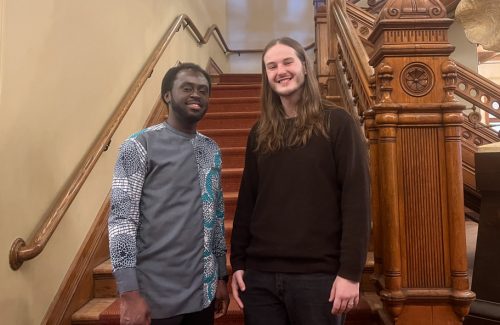
A composer-organist pair of graduate students in the College of Visual and Performing Arts’ Rose, Jules R. and Stanford S. School of Music received a $1,000 grant from the American Guild of Organists (AGO) to compose and perform a new piece for organ.
Composer Ryan McQuay Meredith and organist Joseph Maxwell Ossei-Little were among four pairs selected for the grant from the AGO’s Student Commissioning Project this year. The students used the opportunity to explore the vast capabilities of the organ, pushing its limits.
Meredith’s composition, “Polluted Skies,” consists of two movements, “Clouds” and “Stars.” The piece mimics a cloudy sky that eventually opens into a starry night.
A massive mechanical instrument, the organ always fascinated trombonist Meredith. Housed in Crouse College’s Rose and Jules R. Setnor Auditorium, a 3,823-pipe Holtkamp Organ is part of what attracted him to Syracuse University.
“There’s a lot of magic tricks you can pull off on the organ,” says Meredith. “Specifically with our organ, there’s a lot of options where you can have one hand do an orchestra’s worth of what you want.”
The completed composition broadened organist Ossei-Little’s musicality, allowing him to play with unique rhythms and contribute his own voice to the growth of the organ community.
“What really got me interested in the project is this whole idea that my professor has been championing about expanding the repertoire of the organ,” he says.
A composer-organist pair themselves, Setnor Associate Professor Anne Laver and Assistant Professor Natalie Draper guided the students throughout the project.
The creation of new compositions can have a large impact on the evolution of the instrument, Ossei-Little notes. When large chords became commonplace in compositions, organ builders reacted, making it easier for players to meet the needs of the pieces.
Available on video via the AGO website this summer, “Polluted Skies” will highlight all the organ has to offer. Ossei-Little plans to premiere it at his recital scheduled for Saturday, April 13, at 5 p.m. in Setnor Auditorium.
“It’s a very wonderful opportunity for us to showcase what the organ can do,” Ossei-Little says. “Not just what it used to do in the past but what it can do now.”
